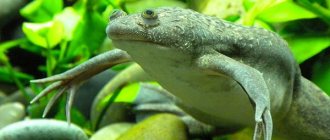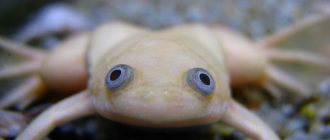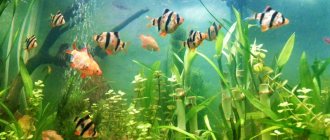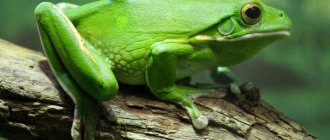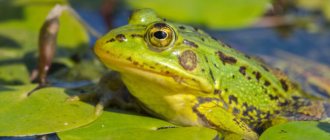The clawed frog (Latin Xenopus, English African clawed frog) is one of the most popular aquarium frogs. Until recently, the only species of frog kept in hobbyist aquariums. They are quite unpretentious, do not need dry land and eat all types of live food. In addition, these frogs are actively used as model organisms (test subjects in scientific experiments).
Habitat in nature
Clawed frogs live in Eastern and Southern Africa (Kenya, Uganda, Congo, Zaire, Cameroon). In addition, they were introduced (artificially populated) in North America, most of Europe, and South America and adapted well there.
They live in all types of water bodies, but prefer small currents or standing water. They tolerate different values of acidity and water hardness well. Hunts insects and invertebrates.
These are rather passive, but very hardy frogs. The lifespan of the clawed frog is up to 15 years, although some sources say about 30 years!
During the dry season, when the reservoirs dry up completely, they burrow into the silt, leaving a tunnel for air flow. There they fall into torpor and can live in this state for up to a year.
If for some reason the pond dries up during the rainy season, the clawed frog can travel a long way to another reservoir.
However, this is a completely aquatic frog that can’t even jump, only crawl. But she swims great. She spends most of her life under water, rising to the surface only for a breath of air, as she breathes with well-developed lungs.
Reproduction of clawed frogs
Claw frog photo
Breeding clawed frogs is not so difficult: the stimulus for spawning for them is warming after the wintering period or a volumetric water change of 45-50%, for frogs this simulates the rainy season, the content of harmful substances in the water sharply drops, the living conditions of the frog improve, which means , it's time to leave offspring. Clawed frogs can be very prolific and have been known to lay more than 5,000 eggs. Parents should be isolated from tadpoles. The tadpoles of the clawed frog are filter feeders, that is, they feed on suspended matter floating in the water. You can feed them with a decoction of nettle diluted with yogurt.
Description
There are several subspecies of frogs in the genus, but they are quite similar and it is unlikely that anyone in pet stores will understand them. We will talk about the most common one - Xenopus laevis.
All frogs of this family are tongueless, toothless and live in water. They do not have ears, but they have sensory lines along the body with which they sense vibrations in the water.
They use their sensory fingers, sense of smell, and lateral lines to search for food. They are omnivores and eat everything living, dying and dead.
If you have a question - why was she called a spur, then look at her hind legs. The frog uses its front legs to push food into its mouth, but its back legs tear apart the prey if necessary.
Remember that these are omnivores, including scavengers? They can eat dead fish, for example.
For this purpose, long and sharp claws are located on the hind legs. They reminded scientists of spurs and the frog was named spur frog. But in English it is called “African Clawed Frog” - African clawed frog.
In addition, the claws also serve for self-defense. The caught frog presses its paws and then sharply straightens them, trying to slash the enemy with its claws.
In nature, these frogs are most often green in different shades with a light-colored abdomen, but in aquariums, albinos with red eyes are more popular. They are often confused with another species of frog, the pygmy clawed frog.
However, it is quite easy to distinguish them from each other. Clawed frogs have membranes only on their hind legs, while African dwarf frogs have membranes on all their legs.
Xenopus laevis can live up to 15 years in the wild and up to 30 years in captivity. In nature they reach 13 cm, but in an aquarium they are usually smaller.
Every season they molt and then eat their skin. Despite the absence of a vocal sac, males make a mating call of alternating long and short trills, contracting the internal muscles of the larynx.
Kinds
This type of living beings is famous for its antiquity. There are several known fossil species, the period of existence of which on Earth is estimated at tens of millions of years. It is interesting that when (and this was at the beginning of the 21st century) experts deciphered the genome of these representatives of the fauna, they unambiguously established that 360 million years ago, frogs of this type and humans had a common ancestor on the planet. Of the species of clawed frogs currently known in nature, about eighteen have been described, but only five of them are kept in aquariums. The most interesting ones should be mentioned in more detail. The common clawed frog is one of the very famous and widespread. Representatives of the species are generally greenish-gray in color, swim extremely quickly and successfully hunt small fish.
These are inhabitants of the northeastern regions of Africa, and are also found further south. During their life, they practically never leave water bodies. The only exceptions are the driest periods, when due to the drying out of some, they are forced to wander and look for other water shelters. As experimental specimens, such creatures are often used in biology and embryology for a variety of scientific experiments. In addition to the color already mentioned, their color can be brown and gray, there are also darker, marbled ones with cream bellies. The albino clawed frog is a very popular commodity, and therefore is successfully sold as a pet.
Their very existence is not the result of any disease or natural mutation (as often happens in other representatives of the fauna). This is a variety specially bred at the Institute of Biology in Moscow for aquarium keeping. What is the advantage of albinos over their counterparts, besides the original color, of course, and why do nature lovers like them so much? First of all, these specimens are larger and have a length of up to 16 cm. In addition, they are less wild and get used to people easier and faster. In addition to white, such creatures can also have a soft pink body tint, which looks original and extremely beautiful.
Care and maintenance in the aquarium
Since this is a completely aquatic frog, it requires a spacious aquarium and does not require land. The optimal volume for keeping is quite difficult to calculate, but the minimum is 50 liters.
Despite the fact that they cannot jump and live in water, the aquarium must be covered with glass. These frogs are able to get out of the aquarium and travel in search of other bodies of water, as they do in nature.
For maintenance you will need:
- aquarium from 50 liters
- cover glass
- shelters in the aquarium
- gravel as soil (optional)
- filter
The question of soil is open because on the one hand it makes the aquarium look more beautiful and natural, on the other hand food debris and waste accumulate in it, which means the water quickly loses its purity.
If you decide to use soil, it is best to choose medium-sized gravel. The frog can swallow sand and fine gravel, which is undesirable.
Water parameters for the clawed frog are of no practical importance. They live well in both hard and soft water. Tap water must be allowed to stand so that the chlorine evaporates from it. Of course, you cannot use water after osmosis and distillate.
You need to place shelters in the aquarium. These can be artificial and live plants, driftwood, pots, coconuts, etc. The fact is that these are nocturnal animals; during the day they are less active and prefer to hide.
Important point ! Even though they are frogs and must live in a swamp, they need clean water in the aquarium. Firstly, you need to replace it with fresh one weekly (up to 25%). Secondly, use a filter. Ideally, an external filter, with a focus on mechanical filtration.
Clawed frogs love to eat and produce a large amount of waste during feeding. This waste quickly poisons the water in the aquarium, leading to the death of the frogs.
They are indifferent to lighting. This is a big plus, since they don’t need lamps at all, let alone special ones. If you are not aware, many species of amphibians (especially those that live both in water and on land) require special heating lamps.
Claw frogs live in water and do not need lighting at all. You can use a lamp to make the aquarium better visible, you just need to respect the length of daylight hours and turn off the lights at night. Also, don't use lights that are too bright.
Another advantage in keeping is their undemanding temperature. Regular room temperature is comfortable for them, but 20 – 25 °C would be ideal.
Filtration
In an aquarium with African clawed frogs, filtration is a must because they are very unclean and produce a lot of waste (they can be compared to goldfish in their ability to litter), and at the same time they are very sensitive to water pollution.
It is better not to use underground and airlift filters, since frogs clog the aquarium 24 hours a day and 7 days a week - these filters simply cannot withstand such a load. Hinged power filters that do not create a strong current are best, and canister filters are a very good choice. Both of these designs are not too expensive, but the filters will be great helpers in purifying waste water.
Feeding
One of the most exciting processes, as over time, clawed frogs can take food from your hands. At the same time, you don’t have to be afraid of bites, since they don’t have teeth. As well as the language, however.
What to feed? The choice is large. This can also be special food for aquatic frogs and turtles. This could be a live fish, such as a guppy. These could be insects from a pet store. Some even feed food for dogs and cats, but this is not recommended!
In general, live, frozen, artificial food - the clawed frog eats everything. Including carrion.
In any case, remember about balance and alternate feeds.
How much food to give a frog needs to be determined experimentally. Much depends on age and size. As a rule, they are fed daily, giving as much as the frog can eat within 15-30 minutes.
Overfeeding usually causes less problems than underfeeding, as they simply stop eating when they are full. In general, you need to look at how your frog eats and looks. If she is obese, then feed her every other day, if she is thin, then daily and give her different foods.
Substrate
Even in the case of this tree frog, providing a good substrate in the enclosure will help create and maintain an environment similar to its natural warm, humid tropical habitat.
Construct the foundation of the bottom of the tank from large washed gravel, covered with soil that does not contain chemicals. Larger pieces of bark can then be used for a larger base.
Cover any exposed soil with sphagnum moss, which helps retain moisture, which provides the humidity these amphibians need.
Avoid fine gravel or bark shavings that frogs might accidentally ingest. Some owners prefer a simpler approach for temporary tanks, simply lining the tank with paper or paper towels for easier cleaning.
However, with such minimal flooring, maintaining adequate humidity is much more difficult.
Compatibility
Clawed frogs are aggressive and persistent hunters with a large appetite. They are omnivores and are capable of hunting small and medium-sized fish. They cannot be kept with small fish. But it is not advisable to keep them with large ones.
For example, cichlids (angelfish, astronotus) themselves can hunt clawed frogs, and other large fish can bite off their fingers.
In this regard, it is recommended to keep them separately. You can do it alone, but it’s better and more interesting in a group. This group can contain one female and several males. However, individuals must be selected of a similar size due to the frogs' tendency to cannibalism.
Diseases
Diseases affecting clawed frogs are largely associated with errors in care.
Poor water purification, low temperature, dirty food are the main causes of disease. What problems may arise:
- Sepsis, or “red leg” . An infectious disease marked by redness of the abdomen and blanching of the skin on the back. As sepsis progresses, the paws swell and ulcers appear. Treatment: baths with a solution of sulfadimidine (15 ml of medicine per 10 liters of water).
- Fungus , in which the affected areas are distinguished by growths of a cotton structure. Salt baths help kill the fungus.
- Dropsy . The main symptom is that the frog's body swells. The patient needs to be placed in a container with a solution of Gentomycin.
- Nematodes . Parasites enter the amphibian's body with food. The skin becomes gray, appetite disappears, and small worms can be seen in areas of peeling. Treatment uses drugs against nematodes (Piperazine or Panacur).
Funny and smart, clawed frogs, unlike fish, often become pets and almost family members.
They are given names, their lives are observed by young and old. With proper care, this warm contact can last for many years.
Sex differences
Male and female frogs can be easily distinguished by the following differences. Males are usually about 20% smaller than females, with slender bodies and legs. Males make mating calls to attract females, which sound very similar to the cry of a cricket underwater.
Females are larger than males and appear much plumper with bulges above their hind legs.
Both males and females have a cloaca, which is a chamber through which food waste and urine pass. In addition, the reproductive system is also emptied.
Owner reviews
According to owner reviews, aquarium frogs are good pets. It is interesting to watch their actions; they soon remember their owner and become attached to him. Breeders are attracted by the ease of maintenance and lack of hassle. Well suited for beginners and people with allergies to wool or leather. The animal can also be entrusted to a responsible child due to the ease of care.
Nutrition
The clawed frog is omnivorous. At home, her diet should be varied and balanced. These are dry, live and frozen types of food.
For example:
- Mealworms and earthworms;
- Bloodworm, Artemia, Gammarus;
- Shrimp meat and fish fillet;
- Feeding insects;
- Special fortified flakes and granules.
As a treat, you can sometimes give frogs pieces of beef heart, but not often. It is too high in calories for them and frequent eating can cause blockage of blood vessels. Frogs are prone to gluttony, so it is recommended to feed adults once every two to three days.
The clawed frog is quite hardy and very poor living conditions can provoke diseases. But with proper care, these interesting amphibians can live 10-15 years.
